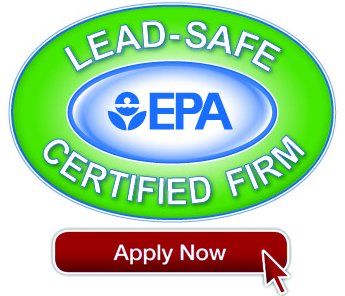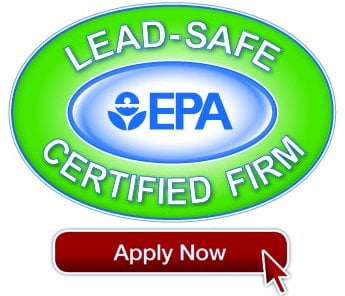Become an EPA Certified Firm
Apply For or Update Your Renovation Firm’s Lead-Safe Certification Today!
It’s easy for renovation firms to apply for EPA’s lead-safe certification, renew their certification or provide information updates. Applications are done online and certificates are emailed in a couple of weeks. Please add [email protected] to your contacts to ensure delivery of your certificate!
Before you proceed please be aware:
- EPA certification does not apply in Alabama, Delaware, Georgia, Iowa, Kansas, Massachusetts, Mississippi, North Carolina, Oklahoma, Oregon, Rhode Island, Utah, Washington, and Wisconsin, or in the Bois Forte Tribe. If you work in one of these areas you must apply directly to that program.
- EPA Certified Firm fee is $300 for a five-year certificate.
- All of your employees must be trained, and a “Certified Renovator” must be assigned to each job.
- Your certificate and customized logo are also sent to your CDX inbox, so if you don’t see the approval in your email check there. Just keep in mind it may take a week or two for the application to be approved.
- If you have any questions, ask an Abreu Training team member today! (203) 757-7202
Certified Firm Application
Firms that Require Certification
In general, anyone who is paid to perform work that disturbs paint in housing and child-occupied facilities built before 1978 must be certified. This includes all firms, even sole proprietorships.
Examples of the types of firms covered:
- Residential rental property owners/managers;
- General contractors; and
- Special trade contractors, including painters, plumbers, carpenters and electricians.
Firms cannot advertise or perform renovation activities covered by the RRP Rule in homes or child-occupied facilities built before 1978 without firm certification.
Activities Covered By the Rule
- In general, any activity that disturbs paint in pre-1978 housing and child-occupied facilities is covered, including:
- Remodeling and repair/maintenance;
- Electrical work;
- Plumbing;
- Painting preparation;
- Carpentry; and
- Window replacement.
- The following housing or activities are not covered by the rule:
- Housing built in 1978 or later;
- Housing specifically for elderly or disabled persons, unless children under 6 reside or are expected to reside there;
- “Zero-bedroom” dwellings (studio apartments, dormitories, etc.);
- Housing or components declared lead-free by a certified inspector or risk assessor. Also, a certified renovator may declare specific components lead-free using an EPA recognized test kit or by collecting paint chip samples for analysis by an EPA recognized laboratory; and
- Minor repair and maintenance activities that disturb 6 square feet or less of paint per room inside, or 20 square feet or less on the exterior of a home or building. (Note: Window replacement, and partial and full demolition activities, are always covered regardless of square footage. Activities designated as “prohibited” are prohibited regardless of square footage.).
How much will it cost contractors to comply with the RRP Rule?
Answer: In order to comply with the RRP rule, renovators will incur costs for EPA certification and costs to take a training course from an EPA-accredited training provider, as well as for supplies needed in order to carry out the required lead-safe work practices designed to reduce exposure to lead dust from renovations.
Firm Certification and Training Costs: The rule requires renovation firms to become certified by EPA or an EPA-approved state RRP program in order to perform renovation, repair or painting activities for compensation in target housing or child-occupied facilities. EPA is required by law to charge firms a fee that covers the government’s cost of administering the program. Firm certification is valid for five years. The fee for most firms is $300, which is equivalent to a cost of $60 per year.
In addition, the rule requires that firms use trained certified renovators for certain key parts of the job, such as containing the work area and conducting cleaning verification after the job’s completion. In most cases, firms have at least one certified renovator on staff. To be a certified renovator, an individual must take a training course from a private training provider accredited by EPA. The training is valid for five years. The cost of the training course is set by the private training provider and varies, but averages $186 (which is equivalent to a cost of about $40 per year). The trained renovators can then provide on-the-job training to their workers. Firms may also incur additional costs related to training and certification, such as the time spent on the activities, and for traveling to and from the training. EPA estimates that this costs $562 per person trained. This includes a tuition cost of $186, the value of time for the eight hours the renovator is in class ($253), the value of time for two hours traveling to and from class ($63), mileage costs to drive to and from the training ($49), and lunch while at the training ($9).
Costs Associated with Lead-Safe Work Practices: Aside from the fixed costs for training and certification, renovators will also incur costs that vary depending on the size, type, and number of jobs performed.
Lead test kits. Renovators may choose to use lead test kits to determine whether lead-based paint is present before the start of the job. The total cost of the lead test kits used depends on the number components tested, but is estimated to average $10 per job. The use of lead test kits is optional, but many renovators find the lead test kits helpful for determining which parts of the job are subject to the rule’s work practice requirements.
Labor, equipment and supply costs. The rule also requires renovators to use work practices in order to reduce exposure to lead dust. As part of the rulemaking process, EPA estimated the labor, equipment, and supply costs for these work practices. To calculate the costs for the rule’s containment, cleaning, and cleaning verification requirements, EPA considered nine categories of renovation events (kitchen renovation, window replacement, painting, etc), for up to three sizes (small, medium, and large square footage) in up to three different dwelling types (single-family owner, single-family rental, and multi-family rental) and in child-occupied facilities.
EPA first estimated an absolute cost of complying with the lead-safe work practices required by a rule if a renovator did not use any containment, or perform any cleaning, or cleaning verification prior to the rule. EPA estimated the labor and materials costs associated with each lead-safe work practice for the various job types included in the analysis.
However, EPA heard from the industry that renovators had been taking steps to control dust from renovations prior to the promulgation of the rule. Based on this input, EPA estimated an average incremental cost of each lead-safe work practice by subtracting the cost already being incurred by renovators for containment and cleaning from the estimate of the absolute cost of the rule’s requirements.
For typical jobs in single-family homes, EPA estimated that the average absolute costs to comply with the rule ranged from $35 to $376, depending on the size and nature of the job. The average incremental costs of complying with the rule ranged from $8 to $124. For example:
For a large window replacement job in a single-family home (12 windows), the average cost ranges between $124 for contractors who already used some of the required work practices, to $376 for contractors who did not use any of the required work practices.
For a medium-sized job removing portions of a wall in a single-family home (such as might be done to repair water pipes or electrical wiring), the average cost ranges between $41 for contractors who already used some of the required work practices, to $121 for contractors who did not use any of the required work practices.
For an exterior painting job involving four exterior walls, the average cost ranges between $90 for contractors who already used some of the required work practices, to $245 for contractors who did not use any of the required work practices.
Finally, firms incur a cost for paperwork and recordkeeping, in order to demonstrate compliance with the RRP rule’s training and work practice requirements.
Renovators conduct millions of jobs each year, ranging from simple drywall repairs to complete kitchen and bath renovations, and from window replacements to building additions. While EPA estimated the compliance costs for various general sizes and types of work, EPA’s cost model is a simplified representation that cannot capture all of the variations from one job to another. EPA’s methodology does not estimate the cost for any individual job performed by a particular renovator.
The cost for a particular contractor to comply with the rule may be considerably different from the sample jobs EPA considered, depending on factors such as the size, configuration, or other conditions of the work area; how the contractor uses his or her discretion to comply with the rule; and the prevailing local wage rates. Furthermore, EPA only estimated the cost of the work practices required by the rule. Some contractors may choose to take additional precautions beyond those required by the rule. These steps may provide extra protection for residents and renovation workers, but they also increase the cost of the work. And because EPA’s estimates reflect the cost to contractors, not the price paid by homeowners, the estimates do not include the contractor’s mark-up for profits.
The purpose of EPA’s analysis was to compare the national cost of the rule’s requirements to the national benefits of the rule. The analysis indicated that the requirements of the rule are not excessive or overly burdensome in light of the importance of avoiding the potentially severe consequences of exposure to lead-based paint hazards.


